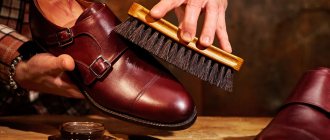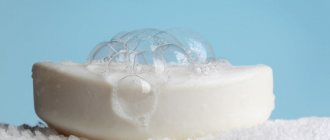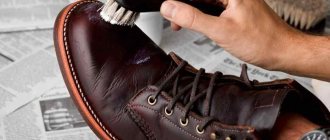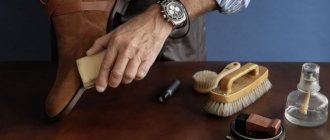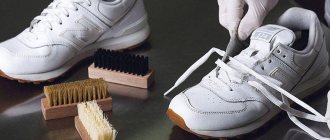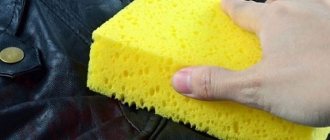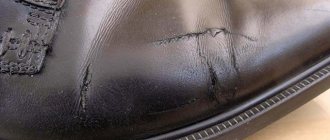Shoes wear out faster than any other item of clothing. Therefore, you need to start monitoring it immediately after purchase. A leather pair needs to be cleaned, nourished and protected regularly. The main thing in this matter is not to overdo it. For natural materials, lack and excess of moisture are equally destructive. But even with a huge selection of modern store-bought products, a universal one does not yet exist. Different colors, types of leather, intensity of wear and even the season affect the condition of the shoes. This means that each problem requires a separate approach.
What are leather shoes afraid of?
Leather shoes are considered strong and durable. However, not everyone knows that she is also “afraid” of certain things.
So, what don’t you like about leather shoes?
- Intensive drying using heating devices. It should be dried at room temperature by filling the inside with paper or inserting wooden spacers.
- Dampness. Wet, poorly dried shoes become greatly stretched and deformed when worn.
- Silicone soaked sponges. Silicone clogs pores, preventing the removal of moisture. This does not apply to patent leather shoes and artificial leather.
- Gasoline, acetone and bleach. They destroy collagen fibers.
Caring for leather shoes at home also has its own rules, non-compliance with which can lead to damage and loss of performance.
Advice! It takes at least a day for leather shoes to dry completely under natural conditions. So if you plan to wear it every day, then don't skimp and get a pair to go with it.
Water-repellent impregnations
Water-repellent impregnations are used to protect shoes from getting wet. They cover the surface with a thin layer so that it is protected from moisture, but “breathes” just as well as before.
Water repellents are as follows:
- Impregnation. Products containing fluoride can be used for any type of shoes. Impregnations with fluorocarbon resin are suitable for suede and nubuck. Silicone is considered a favorite among owners of leather shoes, as it does not allow water to even slightly wet the leather. The impregnation begins to act only 9-10 hours after application, so it is better to treat shoes in the evening.
- Water-repellent spray is the most convenient to use because it does not require additional brushes or sponges. Plus - it retains color. It also has a downside - a very unpleasant, pungent odor, so it should be applied in the fresh air or in a well-ventilated area.
- Creams. Their advantage is that, in addition to repelling moisture, they moisturize the skin and protect it from cracks.
- Unsalted lard, which should be used to rub shoes. It will protect your shoes from both moisture and frost.
Rules for caring for leather shoes
Caring for leather shoes includes daily cleaning, treatment with protective agents and proper storage. The order may vary slightly depending on the type of material, but the basic rules remain the same.
Basic rules for caring for leather shoes:
- You should clean it immediately after returning home. Some types of dirt can leave permanent marks if they are not removed immediately.
- Protective agents are applied several hours before going outside. They must be thoroughly absorbed to be effective.
- Leather shoes can only be dried under natural conditions, avoiding overdrying and exposure to heat.
- For care, you should use only those products that are intended for the type of material from which it is made.
- Leather shoes should be stored in cardboard boxes, after drying them thoroughly, lubricating them with emollient cream and inserting pads inside or tightly stuffing them with paper.
Also, there are nuances depending on what material the shoes are made of, natural or unnatural. You will learn further about all the features of how to care for shoes made of genuine leather and artificial leather.
Use specialized care products
They can be purchased from the same shoe store where you purchased your pair. Ideal if you get this set:
- Cleaning agent. It is usually sold in the form of shampoo or foam.
- Cream. These products contain fats or oils that maintain the natural level of moisture in the skin and make it soft and elastic. Creams are available with different pigments (there are other options besides black, white and brown), and they need to be selected to match the color of a particular pair.
- Polish. This is a silicone-based product that, when applied, adds shine to the leather surface.
- Impregnation. This is a protective water-repellent spray that increases the wear resistance of shoes.
- Brush for footwear. Choose a tool with soft bristles. If you have several pairs of leather shoes of different colors, you will have to get a separate brush for each.
- Spacers-form holders. They are necessary for drying and storing leather shoes.
Caring for shoes made of genuine leather
Shoes made of genuine leather are considered one of the most durable, beautiful and comfortable. The leg breathes in it, the foot does not get tired. However, in order for her to retain all her positive qualities for a long time, she must be looked after daily:
- clean;
- dry thoroughly;
- treat with protective and softening agents;
- repair if damaged.
How to distinguish leather from leatherette?
Now you can very accurately fake any material. If you do not want to fall for the tricks of scammers, you need to be able to distinguish between genuine leather and artificial leather. Here are a few signs that help you do this:
- Thickness. Natural leather is usually thicker and its edges are rougher.
- Elasticity. If you press on the natural material, it will become covered with small wrinkles, but will quickly return to its original state.
- Color. When bent and other manipulations, a leatherette product can change shade, which leather shoes will not do.
- Pores. With natural material they will never be located at the same distance. But the pores of leatherette are very smooth.
Smooth leather shoes
How to care for leather shoes with a smooth, untreated surface? For this type of material, short exposure to moisture is not dangerous and can be washed using a mild soap solution. Afterwards, wipe the surface with a damp sponge and wipe dry with a paper towel.
The next stage is drying. Shoes are stuffed with soft paper and placed in a warm, well-ventilated place. It takes a day or two to dry, depending on the degree of getting wet and the ambient temperature. Then the shoes are lubricated with fat-containing cream, allowed to be absorbed, and the remains are removed with a paper napkin. Finally, polish with a special velvet cloth or cloth.
Once a week, smooth leather shoes are treated with water-repellent impregnation. It is applied after the cream, allowed to absorb thoroughly, then polished.
Removing stains
Home methods can also cope with solving more complex problems. It is quite possible to remove stains from leather shoes using folk remedies.
From dark products...
Peculiarities. It is best to apply any available means immediately after the stain appears. This way the fat will not have time to be absorbed and the shoes will be more likely to be preserved. Sprinkle fresh greasy stains with starch, chalk, baking soda or salt. After half an hour, clean it with a brush. Old greasy stains are removed with dishwashing gel.
Procedure
- The gel is applied with a sponge and then wiped with a damp cloth, leaving the surface streak-free.
- If the contamination turns out to be persistent, the procedure is repeated.
- During the process, avoid prolonged contact with the drug, especially if it is a rich green or blue color.
... and light
Peculiarities. Onions help to clean white leather shoes. First, the entire product is wiped with a fresh cut. Then use a dry cloth. Vegetable juice removes dirt and other stains. But there is a drawback - a very unpleasant smell that will last for several days. Therefore, the onion method is replaced by the egg-milk method, with a similar effect.
Procedure
- Raw protein is mixed with half a glass of milk.
- Use a sponge or rag to wash marks on shoes
Patent leather shoes
Afraid of water, frost below -10 0C and heat above +25 0C. It becomes dull from water, and under the influence of temperatures that are prohibitive for it, it cracks. To care for patent leather shoes, use only special silicone-based products. They are applied to a surface cleaned with a damp cloth. Afterwards they are polished with velvet cloth.
How to clean leather shoes with a patent leather surface? If it is dark in color, you can try cleaning it with coffee grounds or dried tea leaves. Light-colored shoes are wiped with a cloth soaked in milk.
If the polish on your shoes has dulled and lost its shine, rub it with an onion cut in half, and then polish it with a cloth.
Treat your shoes with cream or wax every 6–7 wears
And be sure to use the cream after each wet cleansing.
The product should be applied to dry, clean shoes. Do this in a circular motion using the sponge or soft microfiber cloth included in the cream packaging. The cream will protect the skin from the appearance of microcracks, and will also help it maintain elasticity and shine longer.
Photo: Olena Yakobchuk / Shutterstock
Finally, you can apply a polish and rub the surface with a soft brush or special wipes until a characteristic shine appears.
New shoes
Caring for new shoes made of genuine leather consists of initial treatment with water-repellent impregnation and application of a protective cream.
The entire surface is treated with impregnation, then dried thoroughly. Then apply a thin layer of cream and polish.
It is also recommended to first wear your new clothes by walking around in it for a couple of hours at home. If it rubs, then rub the problem area with soap or a candle.
Special preparations for breaking in or cologne, which is used to moisten the inner surface of shoes, will help to stretch tight shoes.
A prophylactic (thin rubber sticker) should be applied to leather soles only after the shoes have been worn and “sat down” on the foot.
Useful tips
With the right approach, leather shoes will last more than one season:
- Wipe your shoes with a dry cloth each time to remove settled dust - it may contain aggressive substances that corrode the skin;
- use special pads for storage: if the shoes are bent, creases and then cracks appear on the leather;
- do not use creams and shoe polish often and in large quantities: their excess leaves greasy stains that are difficult to remove;
- to protect the soles of winter shoes from exposure to aggressive reagents, use a special rubber sticker or regularly lubricate the soles with compounds based on animal fats;
- It is recommended to alternate shoes and not wear one pair for several days in a row: they should have time to dry naturally (about 12-20 hours).
Caring for faux leather shoes
Although such shoes are inferior in many respects to natural leather, they still have one undoubted advantage - they do not allow water to pass through! Therefore, you can safely wear it in rainy weather. High-quality leatherette will protect your feet from dampness and protect you from colds.
It is enough to wash it with soapy water, rinse with clean water and wipe with a clean cloth. Sports shoes can be washed in warm water with shampoo added. After drying, it is lubricated with silicone-based cream.
Removing traces of reagents
You can also remove traces of the reagent yourself without sending the steam to a workshop. Using laundry soap gives good results. The scheme is as follows:
Author:
Zakharova Nina Afanasyevna
I hope you like my article! If you find any shortcomings, just write to me about it! I am always ready for a conversation and will answer any questions you have, ask them!
